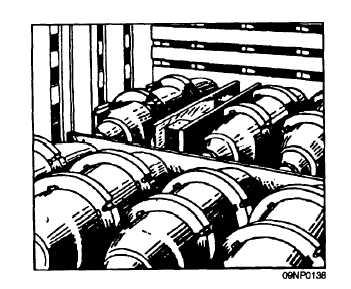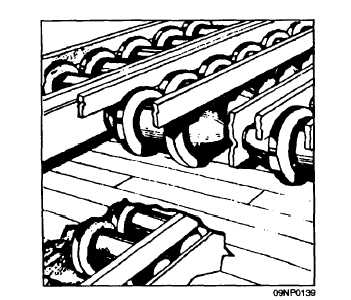| |
Figure 14-12.—Dunnage used to fill space.
EQUALIZES PRESSURE—Figure 14-13
illustrates how dunnage is used in “flooring off’ to
distribute the weight of cargo in succeeding layers.
CRIBBING—Cribbing consists of beams formed
into a framework to provide support to heavy equipment
or other material.
PERMITS DRAINAGE—When laid athwart-
ships or fore and aft, according to the design of the
ship, dunnage permits water to flow into the drainage
system.
PROVIDES VENTILATION—When laid
athwartships or fore and aft, according to the design of
the ship, dunnage provides circulation of air through the
cargo.
Figure 14-13.—Flooring off.
BULKHEAD—Dunnage makes a good bulkhead
against a tier of cargo. Since the bulkhead will provide
considerable stability to the cargo, suitable bracing must
be installed.
CHOCKING AND BRACING—Dunnage can be
used to chock and brace heavy machinery and crates to
prevent shifting. Dunnage serves a useful purpose in
stowing cargo, but it can also damage cargo. For
example, wet dunnage in the hold of a ship produces
excessive moisture that may damage the cargo.
Oil-stained or dirty dunnage can contaminate
foodstuffs. It is a good practice never to reuse dunnage
until it has been inspected, washed and dried as needed,
and sorted for specific purposes.
There is no definite set of rules governing the use
of dunnage. When using it, you should also use thought
and common sense.
Bagged Material
Many commodities are packaged in burlap or paper
bags. Bagged cargo must be stowed so that it will not
be damaged by moisture. Dunnage should be used to
prevent it from touching stanchions, beams, or other
structures that could cut or tear the bag.
Several ways of stacking bags are shown in figure
14-14. Alternating the bags such as shown in view A
makes a more secure stack. The method in view B
provides more ventilation for material that requires it.
View C shows how dunnage may be used to tie together
the stacks, making them more secure and also providing
increased ventilation. Stacking as shown in view D
permits more bags to be stowed in a given space but
ventilation is greatly reduced.
Cases and Cartons
Generally, cargo consists of an assortment of
wooden and fiberboard boxes and cases constructed in
various sizes and shapes, and which may or may not be
palletized. Careful planning is necessary when you are
stowing such cargo. Skill is also necessary in placing
dunnage. The largest and heaviest cases should be
stowed in the lower holds, and the smaller boxes should
be placed between and around them. This protects the
smaller and lighter cartons and helps to keep the tiers
level. Also less dunnage is required. Figure 14-15
shows another example of using dunnage to floor off,
to distribute the weight of a second level of material
evenly over the first. Using dunnage in this manner is
particularly important when stowing containers of
unequal size and weight.
14-19
|


